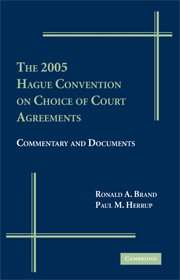Book contents
- Frontmatter
- Contents
- Preface
- PART I A BASIC INTRODUCTION TO THE 2005 HAGUE CHOICE OF COURT CONVENTION
- PART II ARTICLE-BY-ARTICLE COMMENTARY ON THE CONVENTION
- PART III CHOICE OF COURT IN THE ABSENCE OF A MULTILATERAL CONVENTION
- 9 Treatment of Choice of Court Clauses in U.S. Courts
- 10 Recognition and Enforcement of Judgments in the United States: With and Without Choice of Court Agreements
- PART IV LITIGATION AND ARBITRATION CHOICES AFTER THE HAGUE CONVENTION
- Appendix A Explanatory Report by Trevor Hartley & Masato Dogauchi (including the text of the 2005 Hague Convention on Choice of Court Agreements)
- Appendix B Cited Excerpts from the Nygh-Pocar Report
- Index
10 - Recognition and Enforcement of Judgments in the United States: With and Without Choice of Court Agreements
from PART III - CHOICE OF COURT IN THE ABSENCE OF A MULTILATERAL CONVENTION
Published online by Cambridge University Press: 26 October 2009
- Frontmatter
- Contents
- Preface
- PART I A BASIC INTRODUCTION TO THE 2005 HAGUE CHOICE OF COURT CONVENTION
- PART II ARTICLE-BY-ARTICLE COMMENTARY ON THE CONVENTION
- PART III CHOICE OF COURT IN THE ABSENCE OF A MULTILATERAL CONVENTION
- 9 Treatment of Choice of Court Clauses in U.S. Courts
- 10 Recognition and Enforcement of Judgments in the United States: With and Without Choice of Court Agreements
- PART IV LITIGATION AND ARBITRATION CHOICES AFTER THE HAGUE CONVENTION
- Appendix A Explanatory Report by Trevor Hartley & Masato Dogauchi (including the text of the 2005 Hague Convention on Choice of Court Agreements)
- Appendix B Cited Excerpts from the Nygh-Pocar Report
- Index
Summary
INTRODUCTION
The law in the United States on the recognition and enforcement of judgments has undergone substantial discussion and analysis in the past decade. Negotiations at the Hague Conference on Private International Law regarding international instruments on jurisdiction and the recognition and enforcement of judgments in part acted as a catalyst for this attention. When the Hague negotiations were in process, the American Law Institute (ALI) undertook to draft proposed federal implementing legislation for the anticipated treaty. This project also considered the possibility that a treaty would not be concluded, and developed an alternative proposal for federalizing the recognition and enforcement of judgments generally. When the Hague project turned to a Convention on Choice of Court Agreements, the ALI project focused on this second track, and concluded a proposed federal statute that does not include treaty implementing legislation.
The substantive rules on recognition and enforcement of foreign judgments in the United States largely have been left to state law. Thus, when the ALI began moving toward federalization of the law in this area, an equivalent effort was undertaken to reinforce state law on the recognition and enforcement of judgments. In 1962 the National Conference of Commissioners on Uniform State Laws (NCCUSL) had promulgated the Uniform Foreign Money-Judgments Recognition Act. Although thirty states (plus the District of Columbia and the Virgin Islands) had enacted the Uniform Act, others had not.
- Type
- Chapter
- Information
- The 2005 Hague Convention on Choice of Court AgreementsCommentary and Documents, pp. 192 - 212Publisher: Cambridge University PressPrint publication year: 2008

